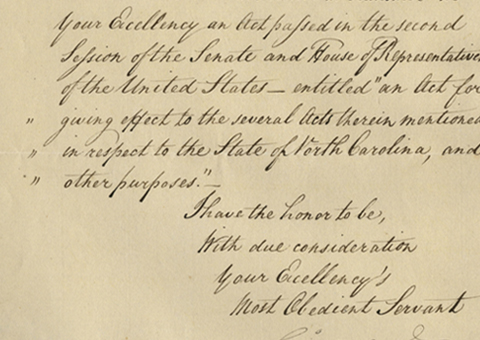sold Gen. George B. McClellan Commences the Peninsula Campaign

A rare autograph telegram signed from the Peninsula, sent the very day his army started on the move .
In response to the call of the President and the country that he move against the Confederates, McClellan rejected taking the overland route to Richmond because it would place the Confederate army between him and his Richmond objective and result in unacceptable casualties. Instead he developed a plan to approach Richmond...
In response to the call of the President and the country that he move against the Confederates, McClellan rejected taking the overland route to Richmond because it would place the Confederate army between him and his Richmond objective and result in unacceptable casualties. Instead he developed a plan to approach Richmond through the back door by landing east of the city on the peninsula, rolling up the small Confederate force guarding that sector, and hitting an exposed Richmond from a direction it was not expecting. He began shipping his 121,500-strong army with all of its supplies and armaments to Fort Monroe on March 17, 1862, intending to move against Richmond by way of the York River. The Army of the Potomac was the largest army to conduct an amphibious operation in North America. The grand army was bigger than any city in Virginia. This was not a bad plan and Confederate prospects looked bleak as McClellan moved his massive army to the Peninsula. Confederate hopes were pinned on Major General John Bankhead Magruder’s small “Army of the Peninsula” to delay the Union juggernaut’s advance toward Richmond long enough for reinforcements to come up.
On April 3, McClellan issued orders to begin the campaign the next morning at 7 AM. He designated 53,000 of his effective troops to move towards Yorktown on the York River from Fortress Monroe. He expected to take Yorktown easily, and to use it as an immediate staging point for his vast army. He also assumed that Williamsburg on the James River would soon follow, and that he would establish a second major staging site there. He would need lots of docking space to more troops, artillery, horses and supplies, more than either of the towns could provide. So as perhaps one of his last acts before starting his movement, he telegraphed the War Department asking that it urgently send him large, flat boats suitable to provide emergency docking space.
Autograph Telegram Signed on his Head-Quarters, Army of the Potomac letterhead, Hampton Roads, Va., April 4, 1862 at 12:45 AM, to Col. D.H. Rucker, aide-de-camp in the Quartermaster Department. “Please send here about (50) fifty canal boats to be used in forming temporary wharves. They should bring down wagons.” The telegrapher has marked “very important” at the bottom, doubtless an instruction McClellan gave him to pass along to Ricker with the text, along with “12:50”, the time it was likely dispatched.
Six hours later, on April 4, 1862, at 7 AM, McClellan’s army began its march up the Peninsula, occupying abandoned Confederate works at Big Bethel and Young’s Mill. The next day, the Army of the Potomac assumed its march only to find its path to Richmond slowed by heavy rains, which turned the already poor roads into a muddy morass. The army then found itself blocked by Magruder’s 13,000-strong command entrenched along a 12-mile front. McClellan ordered the Union army to halt in its tracks as Magruder, despite being heavily outnumbered, created an illusion of having a powerful army with heavy fortifications and lots of artillery guns. Magruder “played his ten thousand before McClellan like fireflies,” wrote diarist Mary Chesnut, “and utterly deluded him.”
The events of April 5 changed McClellan’s campaign. His plans for a rapid movement past Yorktown were upset by the unexpected Confederate defenses, and believing he was outnumbered by the Confederates, he besieged their defenses instead of attacking them. As McClellan’s men built gun emplacements for their 103 siege guns, Gen. Joseph E. Johnston began moving his entire Confederate army to the lower Peninsula. He soon arrived, and by the time Yorktown was taken a month later the Union advantage was lost. The campaign ended in an embarrassing defeat for Union arms.

Frame, Display, Preserve
Each frame is custom constructed, using only proper museum archival materials. This includes:The finest frames, tailored to match the document you have chosen. These can period style, antiqued, gilded, wood, etc. Fabric mats, including silk and satin, as well as museum mat board with hand painted bevels. Attachment of the document to the matting to ensure its protection. This "hinging" is done according to archival standards. Protective "glass," or Tru Vue Optium Acrylic glazing, which is shatter resistant, 99% UV protective, and anti-reflective. You benefit from our decades of experience in designing and creating beautiful, compelling, and protective framed historical documents.
Learn more about our Framing Services







































































































